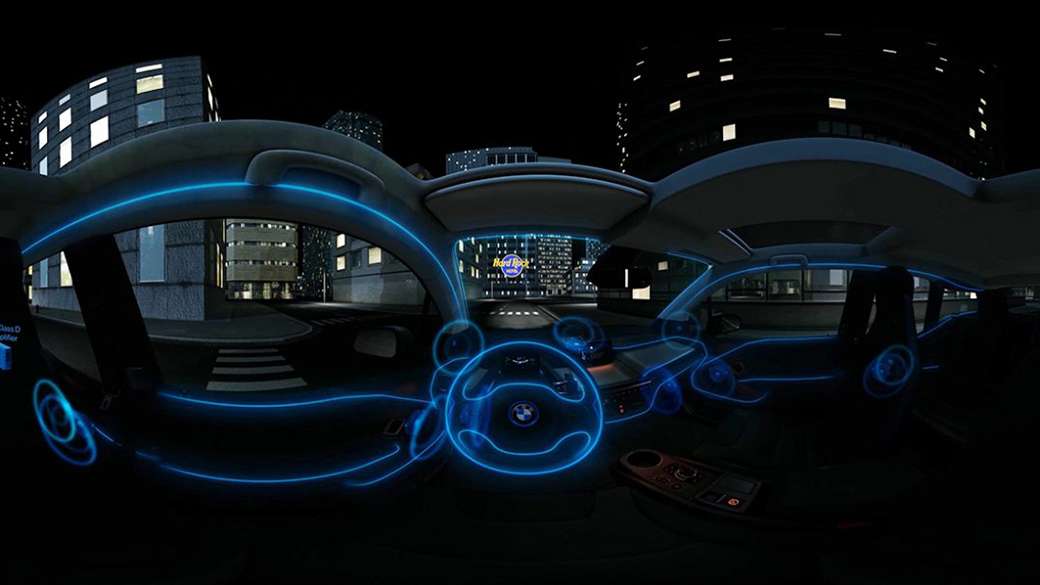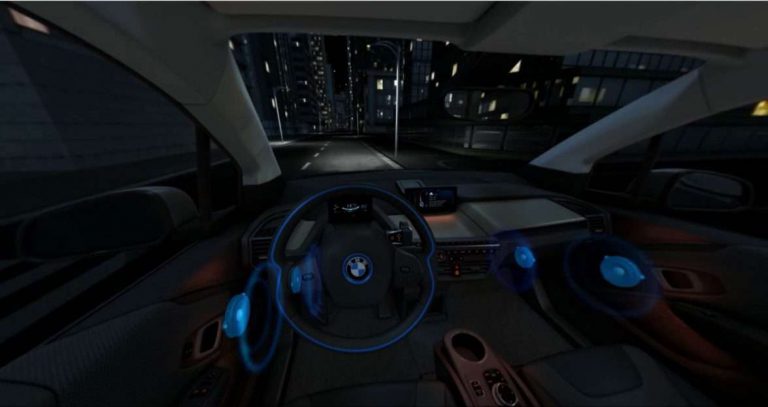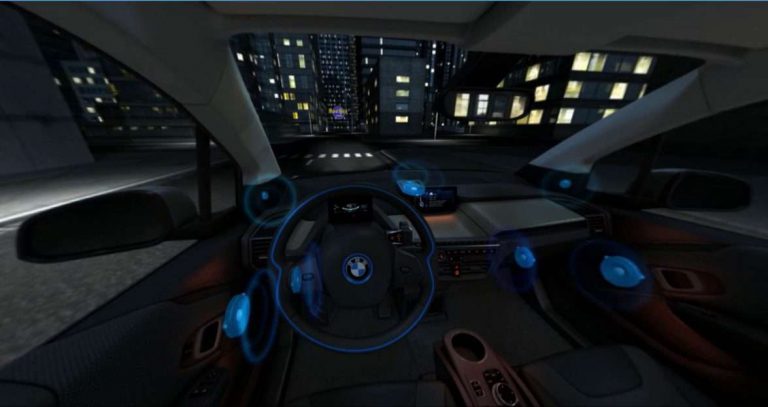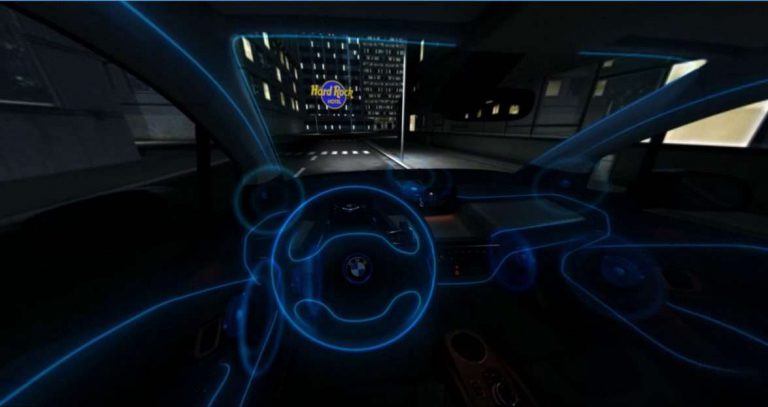
Harman/Kardon BMW at CES Las Vegas (Audio Showroom in VR)
The Harman/Kardon BMW – VR Audio Auto Simulation project was showcased at the CES in Las Vegas and the IAA in Frankfurt, offering visitors the opportunity to immerse themselves in the world of the BMW i3. Through a 360° video and a specially developed VR app for the Samsung GearVR, participants were able to experience the sound in a virtual environment.
The simulation demonstrated the difference between standard stereo playback and a 5.1 surround sound mix, played through the vehicle’s premium audio system.



VR showrooms are becoming increasingly important in the automotive industry as they enable companies to present products and technologies to potential buyers in innovative ways. The combination of 3D audio and virtual reality gives customers the opportunity to create an experience that goes beyond the limits and capabilities of a physical showroom.
What Are VR Showrooms?
VR showrooms, or virtual showrooms, are digital environments where products, services select products, or technologies are presented in an immersive 3D environment. These spaces allow visitors to enter and explore a fully digital world using VR headsets or other virtual reality technologies without physically being there.
A virtual showroom not only offers visual displays of product availability but also interactive elements, such as the ability for buyers to interact with the objects presented, and in this case, to experience the audio showroom. Popular environments for such immersion include museums or trade shows, where businesses aim to captivate people with the power of the technology.
Advantages of VR Compared to Physical Showrooms
One major competitive advantage of VR showrooms is their flexibility. Companies can present their products in an idealized environment without being constrained by the limits of physical retail stores.
VR technology allows large virtual spaces to be simulated and adapted to the needs of the customers, regardless of the availability of physical space. Moreover, visitors from all over the world can attend the exhibition, greatly expanding its reach.
Another significant advantage is the ability to visualize and explain complex technologies. In contrast to physical showrooms in physical stores, where space is limited, a virtual showroom can display multiple products at once without any spatial issues.
The integration of audio in a VR showroom, such as in an audio showroom, further enhances the shopping experience by using 3D audio and binaural sound to intensify the emotional impact.
In summary, VR showrooms provide a cost-effective, location-independent, and technically advanced business solution allowing customers to offer customers an interactive and immersive customer journey.
The Role of Audio in a Virtual Reality Showroom
Audio plays a crucial role in enhancing the immersive retail experience while in a virtual showroom or virtual store. In an environment where sight and sound merge, 3D sound makes the difference between a purely visual presentation and a fully vr environment.
By integrating binaural audio and 3D audio, spatial perception in virtual room is intensified, making visitors feel as though they are truly standing in the room or – as in the case of the BMW i3 – sitting behind the wheel and hearing the vehicle’s sounds in real-time.
How Audio Improves the User Experience in a Virtual Showroom
The ability to replicate sound as realistically as possible in a virtual showroom significantly improves the user experience. Unlike physical and virtual showrooms together, where sound is often limited to speakers, VR enables 360-degree sound that synchronizes with the movement of the viewer.
This means that sounds change according to head and body movements – a key factor for immersion. Especially with products like audio systems, which only fully unfold their impact through sound, audio plays a pivotal role in enhancing the immersive factor.
Audio Features: Stereo vs. 5.1 Mix in the BMW i3
In the Harman/Kardon BMW – VR Audio Auto Simulation project, participants could directly experience the difference between stereo playback and 5.1 surround sound in the BMW i3. The VR simulation allowed them to switch between the two audio modes to perceive the differences in sound quality.
-
Stereo Playback: The sound was delivered via two channels, representing the standard playback found in most vehicles. While this offered a solid sound experience, it lacked the depth and dimensions necessary for a fully immersive experience.
-
5.1 Surround Sound: This premium audio setting allowed visitors to hear sound from various directions – from the front, sides, and even behind. The realistic sound experience was enhanced by the 5.1 system of the vehicle’s premium speakers. Combined with VR technology and head tracking, they could feel the precise position of each sound source, significantly enhancing the feeling of truly being in the car.
These audio features provided a vastly improved perception of the physical store front and sound system and impressively highlighted how important audio is in presenting products in a virtual showroom.
Technical Implementation of the Audio Showroom
The technical implementation of an audio showroom in virtual reality requires close integration between the visual presentation and the audio system to create a fully immersive experience. In the case of the Harman/Kardon BMW – VR Audio Auto Simulation project, the focus was on the 360° video animation and digital showroom, which allowed users to sit in the BMW i3 and experience the sound system in a virtual environment.
Development of the 360° Video Animation and Audio Integration
The development of the 360° video animation for the BMW i3 was based on a fully computer-generated (CGI) model. The stereoscopic 360° video was designed to realistically depict the car’s interior, while the users’ movements in the virtual environment were synchronized with their perception in the real world. It was essential that the visual representation was supported by 3D audio to enhance the immersion in interactive environment.
The audio integration was conducted in stages: initially, the stereo music from the standard speaker system was integrated into the 360° experience. Later, the more advanced 5.1 surround sound mix was added to provide participants with a realistic soundscape. These audio layers needed to be precisely synchronized with the movements and interactions of the users to ensure a seamless VR experience.
Use of Live Headtracking and Binaural Sound for Immersive Experiences
A significant technical advancement in this project was the use of live headtracking. This technology allowed users to transfer their head movements in real-time into the 360° virtual reality vr home environment.
Depending on the direction participants moved or looked, the sound adjusted accordingly. This dynamic sound rendering increased the realism of the experience, ensuring that the sound always aligned with the head’s position – a crucial factor for immersion.
The use of binaural sound was also essential. Through binaural recording, sound was delivered in such a way that it could be perceived from different directions, as if the sound truly came from certain positions within the car. This enhanced the feeling that the user was genuinely sitting in the BMW i3 and experiencing the environment and sound system in real-time.
Programming the App for Samsung GearVR and Later Use on Oculus Rift
To make this experience accessible to participants, a custom VR app was developed for the Samsung GearVR. This app was tailored to play the 360° video and integrate 3D audio simultaneously. The GearVR made access to the VR experience portable and wireless, which was ideal for demonstrations at CES and IAA.
Later, the project was further developed for the Oculus Rift, where the immersive experience was enhanced through higher resolution and improved motion tracking. Additionally, the audio output was expanded to the BMW HiFi system with 12 speakers, allowing the 5.1 surround sound to be played directly through the car’s audio system, merging the virtual environment with the augmented reality one.
Challenges and Solutions in Audio Integration in the VR Showroom
One of the main challenges in the Harman/Kardon BMW – VR Audio Auto Simulation project was creating an audio experience that was both realistic and impressive. The goal was to balance authentic sound with a slightly enhanced hyperreality, similar to what we hear in advertisements.
Creating a Balance Between Realism and Hyperreality in Audio
On the one hand, the audio had to reflect the real characteristics of the BMW i3 – from the positioning of the speakers in the car to the fine audio details that one would expect in a real driving situation. The audio experience needed to be credible, making visitors feel as though they were genuinely sitting inside the car.
This was particularly important for the 5.1 surround sound, where sound was perceived from multiple directions, thus providing customers with an authentic spatial audio experience.
On the other hand, it was essential to create a sense of hyperreality – an enhanced form of realism that elevates the audio beyond normal expectations, similar to what we experience in commercials.
This slightly exaggerated audio design ensured that the sound was not only perceived as realistic but also delivered an emotional punch. For example, the bass was made deeper and the highs sharper, making the sound more powerful and dynamic without losing its authenticity.
Creating a Distinct Difference Between Stereo and 5.1 Surround
Another key objective was to ensure a noticeable difference between stereo playback and 5.1 surround sound, so that participants in the simulation could instantly recognize the contrast. While stereo provided solid sound, the 5.1 mix aimed to create an audio world that filled the entire space of the car.
Every sound source, whether music or environmental noises, was spatially placed to keep the sound in motion and fully envelop the listener. The spatial depth and breadth of the 5.1 mix were clearly evident, while the stereo setup offered a flatter sound profile.
This deliberate contrast highlighted the premium quality of the Harman/Kardon audio system in the BMW i3, showing participants how immersive and room-filling a surround sound mix can be.
With the use of Higher Order Ambisonics (HOA), the sound was further refined to create an immersive soundscape that not only came from the correct directions but also delivered the right intensity and clarity, exceeding expectations.
Conclusion: The Future of Audio in Virtual Reality Showrooms
3D audio and immersive sound design play a crucial role in shaping the future of virtual reality showrooms. These technologies allow companies to present products customer experiences and technologies in ways that surpass the limitations of physical showrooms, offering the benefits and an entirely new level of engagement for customers.
As VR showrooms continue to evolve, the integration of 3D audio will become an essential element in enhancing the customer experience. This will not only transform how products are presented but also enable businesses to redefine the customer journey in the digital age.
With further advances in VR technology and the refinement of 3D audio, VR showrooms will become even more personalized and effective, driving the success of brands on these digital platforms.
Contact me now without obligation